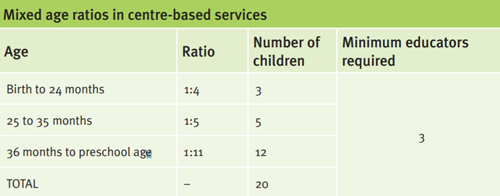In a mixed age group of children, an educator who is caring for one age range of children can also be counted against another age range of children, as long as the ratio for each age range is maintained and adequate supervision is maintained at all times.
Maintaining the ratio for each age range of children in the mixed age group does not mean the educator to child ratio for the youngest age range must be applied to all children in an older age range.
Example 1:

- The number of educators required for this group is three. This is because the educator who is caring for the three children aged 0 to 24 months can also care for one child aged over 24 months and less than 36 months without exceeding the ratio of 1:4.
- This then requires a second educator for the remaining four children aged over 24 months and less than 36 months, who can also care for one child aged 36 months to preschool age.
- A third educator is required for the remaining 11 children aged 36 months to preschool age (1:11).
Calculating Ratios For The Mix Age Group Setting
The first step is to determine the number of educators needed for the youngest age range of children in the group.
Once that ratio is met, an educator can also supervise children in another age range, provided the youngest age range is still maintained.
The above example also shows how an educator may be deployed across more than one age range while maintaining the required ratio for each age range.
Example 2:

- The number of educators required for this group is two (2). This is because the educator who is caring for the five children aged 36 months to preschool age can also care for four children aged over preschool age without exceeding the ratio of 1:11.
- This then requires a second educator for the remaining fifteen children aged over preschool age.
Educator to child ratios are calculated across the service (not by individual rooms) and are based on the youngest child in care. This approach provides flexibility to more effectively respond to the needs of children.
Reference:
Mixed Age Ratios In A Centre Based Services, Quality Area 4, Staffing Arrangments, Guide to the NQS, ACECQA







 As an Educator in Australia, your pay rate falls under the Children’s Services Award 2010. This award states the minimum amount that an employer can
As an Educator in Australia, your pay rate falls under the Children’s Services Award 2010. This award states the minimum amount that an employer can When working as a qualified Early Childhood Teacher (with a university degree) within a service, your rate of pay will come from the Educational Services
When working as a qualified Early Childhood Teacher (with a university degree) within a service, your rate of pay will come from the Educational Services When working as a Diploma Qualified Educator your pay rate is from the Children's Services Award 2010. This Award states your minimum rate of pay
When working as a Diploma Qualified Educator your pay rate is from the Children's Services Award 2010. This Award states your minimum rate of pay When working as a Cert 3 Qualified Educator, your pay rate is from the Children's Services Award 2010. This Award states your minimum rate of
When working as a Cert 3 Qualified Educator, your pay rate is from the Children's Services Award 2010. This Award states your minimum rate of Educational Leaders play a crucial role in their early childhood service by ensuring that the educational program aligns with best practices and supports the holistic
Educational Leaders play a crucial role in their early childhood service by ensuring that the educational program aligns with best practices and supports the holistic In early childhood education and care, ratios are more than a technicality—they are a frontline safeguard. Every child deserves responsive supervision, emotional connection, and developmental
In early childhood education and care, ratios are more than a technicality—they are a frontline safeguard. Every child deserves responsive supervision, emotional connection, and developmental Here’s a comprehensive Mobile Phone and Smart Watch Policy tailored for early childhood education and care (ECEC) services in Australia, aligned with the latest 2025
Here’s a comprehensive Mobile Phone and Smart Watch Policy tailored for early childhood education and care (ECEC) services in Australia, aligned with the latest 2025 With the new national child safety reforms kicking in on 1 September 2025, early childhood services like yours have a real opportunity to lead the
With the new national child safety reforms kicking in on 1 September 2025, early childhood services like yours have a real opportunity to lead the The Sea of Fish Challenge is a national initiative that invites children, educators, families, and communities to create and display fish artworks as a symbol
The Sea of Fish Challenge is a national initiative that invites children, educators, families, and communities to create and display fish artworks as a symbol Across the early childhood education and care sector, educators are sounding the alarm: current staffing ratios are insufficient to deliver safe, meaningful, and developmentally appropriate
Across the early childhood education and care sector, educators are sounding the alarm: current staffing ratios are insufficient to deliver safe, meaningful, and developmentally appropriate


